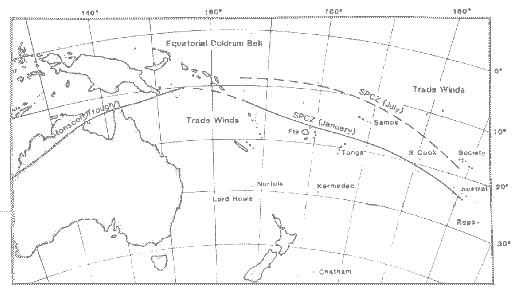 |
Science Frontiers ONLINE No. 101: Sep-Oct 1995 |
|
|
From the sunswept lagoon
Mitchener fans will recognize the above title as heading one of his chapters in Hawaii. Many Polynesian navigators did indeed set out from sunswept lagoons into the superficially featureless Pacific. How did these peoples, a thousand years ago, sail reliably from one speck of land to another, thousands of miles distant? The archeology of Oceania confirms that the Polynesians made such voyages centuries before they learned about compasses and navigation satellites. But were these voyages anomalous; that is, did the Pacific peoples possess devices or talents unrecognized today by mainstream science? For the most part, the answer seems to be NO.
While the navigational abilities of the Polynesian seafarers seemed supernatural to early European explorers, it has been convincingly demonstrated -- through modern voyages -- that the senses of sight, hearing, smell, touch, and time-passage are and were sufficient for most interisland voyages. The early Pacific navigators were adept at observing the waves, stars, birds, clouds, winds, and several other natural phenomena that carry subtle directional cues. There are, however, modern instances in which Pacific navigators bereft of the usual sensory cues seem to employ an anomalous "sense."
B. Finney, in his study of the possibility of human magnetoreception, tells how one native Hawaiian navigator, though wellschooled in traditional Polynesian navigational techniques, conquered the dread doldrums on a 3,000mile voyage from Hawaii to Tahiti in a way we might call "psychic.".
In the doldrums, the sky is often overcast and the seas leaden, expunging the usual cues. This particular navigator, Nainoa Thompson, entered the doldrums on a black night, with 100% cloud cover. The wind was switching around and the waves cueless. Nainoa's own words were:
"It was like I just got so exhausted that I just backed up against the rail, and it was almost as if, and I don't know if this is completely true, but there was something that allowed me to understand where the direction was without seeing it. And it was almost like when I just gave up fighting to try to find something with my eyes. I just settled down and then all of a sudden it was like this warmth came over me...When I sat back and leaned against the rail, I felt this warmth come over me and all of a sudden I knew where the moon was. But you couldn't see the moon it was so black, and then I directed the canoe with all this total confidence at a time when I had already convinced myself prior to the voyage that I would have no confidence in knowing where to go. And I turned the canoe to this particular direction, got things lined up, felt very, very comfortable in this cold, wet, rough environment and then there was a break in the clouds and the moon was there."
(Finney, Ben; "A Role for Magnetoreception in Human Navigation," Current Anthropology, 36:500, 1995.)
 Ancient Pacific navigators making the voyage from Hawaii to Tahiti (in the Society Islands) dreaded crossing the doldrums near the Equator. Hawaii (not shown) is north of Tahiti at about 20°N. SPCZ=South Pacific Convergence Zone. Map from Irwin G.,; The Prehistoric Exploration and Colonisation of the Pacific. (Available from the Sourcebook Project). |
Reference. Human directional and "magnetic" senses are covered in: Biological Anomalies: Humans I. See description of this book here.